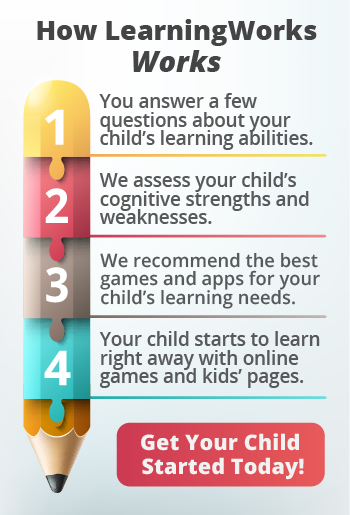This is what we say to explain that accomplishment and long term success are often the results of arduous step-by-step processes. Even if the Rome metaphor doesn’t sink in, a child who wants to become a chess master, learn to play an instrument, or be a sports star needs to quickly learn that the skills of ongoing persistence and effort are crucial. We provide ways to build persistence in this edition of the LearningWorks for Kids Beyond Games series.
Reward stick-to-itiveness. People are more likely to be motivated to try again the next time when they feel the rewards of sticking with and completing a difficult task. Playing sports or a musical instrument can build up goal-directed persistence, and verbal praise can be very meaningful for successful task completion. Provide meaningful rewards such as praise, an outing, or a desired game for chores that are completed to your satisfaction or without any reminders.
Start small. Many people who are overwhelmed by multi-step projects benefit by learning how to break a project into more manageable subtasks. Have a child complete very brief, one-step duties such as taking out the garbage or bringing in groceries from the car after food shopping. Identify the individual parts of a chore and work with a child to acknowledge the importance of each step. Discuss how persistence could help him complete a chore in the most effective and efficient manner. Tasks can be increased in complexity and steps as he becomes more confident and can view tasks in a step-by-step fashion.
Step it up, step-by-step. Figure out how many minutes he can remain on a task by himself and try to increase that amount by a few minutes at a time. Gradually build up the amount of complexity required to complete a task, always beginning with his success. Persistence is always easier while doing a task one likes or when doing it with someone else. A child could expand the areas where he can sustain his effort through new tasks that use his areas of strength. For example, children who are good readers could turn this skill into a project that can build persistence by helping younger children put on a play.
Show and tell. It may be difficult for a child to recognize why and how it is important to stick to an individual task. He could benefit from recognizing and reflecting on the individual steps he has taken in completing a task in order to appreciate the rewarding nature of persistence. Try taking digital pictures of him while he is doing a science project. The first picture might include a layout of all of the materials, while the next photo sets might show him reading books on the topic, beginning to conduct an experiment, creating a poster about it, and then standing by the completed final project. The same type of progression could be shown in pictures of him building a shelving unit in the home, creating a large Lego castle or ship, or transitioning a very messy room into a very clean, organized room. These photographs could help him recognize how far he has come and how rewarding his persisting at a task can be.
[cjphs_content_placeholder id=”73541″ random=”no” ]Complementing these core strategies with the use of apps, websites, and other technologies often leads to the best solutions to improve a child’s ability for building persistence habits. Some of the best tech tools to help a child build persistence and effort include:
![]() Weave is a productivity app for Android and iOS devices that allows users to keep multiple individual calendars and assign tasks to other users, making it perfect for parents who want to oversee their children’s schedules. While the app has features (like budgeting) that make it useful for adults, its user-friendly enough for use by kids as young as 8.
Weave is a productivity app for Android and iOS devices that allows users to keep multiple individual calendars and assign tasks to other users, making it perfect for parents who want to oversee their children’s schedules. While the app has features (like budgeting) that make it useful for adults, its user-friendly enough for use by kids as young as 8.
 Another productivity app for kids 8 and older is the sleek and simple Any.do. Any.do is extremely user friendly and visually clean, allowing kids to easily add, update, and see scheduled tasks and responsibilities, even drag them from folder to folder for more accurate categorization. Parents might find it most helpful to create folders for their children to add tasks to.
Another productivity app for kids 8 and older is the sleek and simple Any.do. Any.do is extremely user friendly and visually clean, allowing kids to easily add, update, and see scheduled tasks and responsibilities, even drag them from folder to folder for more accurate categorization. Parents might find it most helpful to create folders for their children to add tasks to.
 An entertaining way to get kids to look at the details in relation to the big picture is the iOS app, Seene. Seene lets users take multiple photos of a subject in order to create a 3-D image. The app exercises flexibility and focus, as well as helping kids see the fun in breaking down a larger goal into individual steps.
An entertaining way to get kids to look at the details in relation to the big picture is the iOS app, Seene. Seene lets users take multiple photos of a subject in order to create a 3-D image. The app exercises flexibility and focus, as well as helping kids see the fun in breaking down a larger goal into individual steps.
Featured image: Flickr users Michael McCauslin





